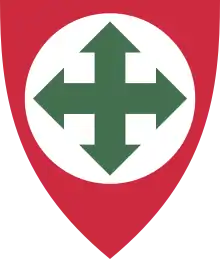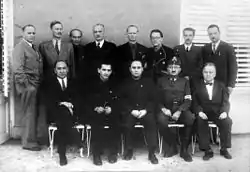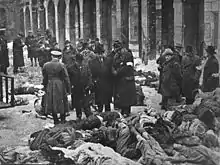Arrow Cross Party
The Arrow Cross Party (Hungarian: Nyilaskeresztes Párt – Hungarista Mozgalom, literally "Arrow Cross Party-Hungarist Movement", abbreviated NYKP) was a far-right Hungarist party led by Ferenc Szálasi, which formed a government in Hungary known as the Government of National Unity. They were in power from 15 October 1944 to 28 March 1945. During its short rule, ten to fifteen thousand civilians (many of whom were Jews and Romani) were murdered outright,[2][3] and 80,000 people were deported from Hungary to various concentration camps in Austria.[4] After the war, Szálasi and other Arrow Cross leaders were tried as war criminals by Hungarian courts.
Arrow Cross Party – Hungarist Movement Nyilaskeresztes Párt – Hungarista Mozgalom | |
|---|---|
 | |
| Abbreviation | NYKP |
| Leader | Ferenc Szálasi (1935–1945) |
| Founder | Ferenc Szálasi |
| Founded | 4 March 1935 (as the National Will Party) 15 March 1939 (Reconstituted as the Arrow Cross Party) |
| Dissolved | 7 May 1945 |
| Merger of | • Christian National Socialist Front • United National Socialist Party |
| Headquarters | Nap utca 19, Budapest (first) Andrássy út 60, Budapest (last) |
| Membership (1939) | 300,000 |
| Ideology | Hungarism • Hungarian nationalism • Clerical fascism • Agrarianism • Hungarian Turanism • Fascism • Nazism |
| Political position | Far-right |
| Religion | Roman Catholicism |
| Colours | Red white green (Hungarian national colours) |
| Slogan | "Felébredek, magyar!"" ("Awaken, Hungarian!")[1] |
| Anthem | "Ébredj Magyar" ("Hungarian Arrow Cross Party Anthem") |
| Most MPs | 29 / 260 (1939) |
| Party flag | |
 Other Flags:
| |
Formation
| Part of a series on |
| Nazism |
|---|
|
The party was founded by Ferenc Szálasi in 1935 as the Party of National Will.[5] It had its origins in the political philosophy of pro-German extremists such as Gyula Gömbös, who famously coined the term "national socialism" in the 1920s.[6] The party was outlawed in 1937 but was reconstituted in 1939 as the Arrow Cross Party, and was said to be modelled fairly explicitly on the Nazi Party of Germany, although Szálasi often and harshly criticised the Nazi regime of Germany.[7] The iconography of the party was clearly inspired by that of the Nazis; the Arrow Cross emblem was an ancient symbol of the Magyar tribes who settled Hungary, thereby suggesting the racial purity of the Hungarians in much the same way that the Nazi swastika was intended to allude to the racial purity of the Aryans.[8] The Arrow Cross symbol also referred to the desire to nullify the Treaty of Trianon, and expand the Hungarian state in all cardinal directions towards the former borders of the Kingdom of Hungary.[8]
Ideology

The party's ideology was similar to that of Nazism or Fascism[9] and Hungarian Turanism combined, which was called Hungarism by Ferenc Szálasi – nationalism, the promotion of agriculture, anti-capitalism, anti-communism and a special type of anti-Semitism, called a-Semitism. In a series of four books on Hungarism, Szálasi distinguished between a-Semitism, which called for a society completely absent of Jews, and anti-Semitism, which, he argued, would nominally allow Jews to exist in a particular society with limited rights. He argued that a-Semitism was not opposed to the existence of Jews per se; it was opposed to their existence in as being incompatible with European society. Szálasi extended this argument to Arabs as well, as a matter of fact to the whole Semitic Race.[10] The party and its leader were originally against the German geopolitical plans, so it was a long and very difficult process for Hitler to compromise with Szálasi and his party (they introduced the doctrine of connationalism, meaning the support of nationalist movements on their historical territories and influence spheres on the ground of the historical heritage and proven availability of cultural dominance; something that the Germans hardly understood, a kind of combination of nationalism and internationalism, the co-operation of the nations and their nationalist movements). Consequently, the party conceived Jews in racial as well as religious terms as incapable to be integrated into the society outside the place and culture of their historical origin. Although the Arrow Cross Party was certainly far more racist than the Horthy regime, it was still different in some ways from the German Nazi Party. It was also more economically radical than other fascist movements, advocating advanced workers' rights and land reforms.[8]
Rise to power
The roots of Arrow Cross influence can be traced to the outburst of anti-Semitism that followed the Communist putsch, the creation of the Hungarian Soviet Republic, and Red Terror during the spring and summer of 1919. Some Communist leaders, like Tibor Szamuely, came from Jewish families. Béla Kun, the Republic's leader and mastermind of the Terror, had a secular Jewish father and a mother who had converted to the Reformed Church of Hungary, and was considered to be a Jew. The policies of the Hungarian Soviet Republic came to be credited in the minds of some anti-communists to a "Judeo-Bolshevist conspiracy."
After the Soviet Republic was overthrown in August 1919, conservative authoritarians under the leadership of Admiral Miklós Horthy took control of the nation. Many Hungarian military officers took part in the counter-reprisals known as the White Terror – parts of that violence was directed at Jews, as they were broadly blamed for the events in connection with the Soviet Republic.[8] Although the White Guard was officially suppressed, many of its most prevalent members went underground and formed the core membership of a spreading nationalist and anti-Semitic movement.
During the 1930s, the Arrow Cross gradually began to dominate Budapest's working class neighborhoods defeating the Social Democrats. The Social Democrats did not really contest elections effectively; they had to make a pact with the conservative Horthy regime in order to prevent the abolition of their party. The Arrow Cross party recruited as well from the poorest and anti-social parts of society, the social classes which at that time in Hungary were often called "scum" or "trash", i.e unemployed, alcoholics, ex-convicts, prisoners, rapists, and the uneducated.[11] Many of these anti-social members later committed some of the most brutal crimes against Jews, intellectuals, socialists, and other civilians.

The Arrow Cross subscribed to the Nazi ideology of "master races",[8] which, in Szálasi's view, included the Hungarians and Germans, and also supported the concept of an order based on the power of the strongest – what Szálasi called a "brutally realistic étatism". But its espousal of territorial claims under the banner of a "Greater Hungary" and Hungarian values (which Szálasi labelled "Hungarizmus" or "Hungarianism") clashed with Nazi ambitions in central Europe, delaying by several years Hitler's endorsement of that party.
The German Foreign Office instead endorsed the pro-German Hungarian National Socialist Party, which had some supporters among ethnic Germans. Before World War II, the Arrow Cross were not proponents of the racial antisemitism of the Nazis, but utilised traditional stereotypes and prejudices to gain votes among voters both in Budapest and the countryside. Nonetheless the constant bickering among these diverse fascist groups prevented the Arrow Cross Party from gaining even more support and power.
The Arrow Cross obtained most of its support from a disparate coalition of military officers, soldiers, nationalists and agricultural workers. It was only one of a number of similar openly fascist factions in Hungary but was by far the most prominent, having developed an effective system of recruitment. When it contested the May 1939 elections – the only ones in which it participated – the party won 15% of the vote and 29 seats in the Hungarian Parliament. This was only a superficially impressive result; the majority of Hungarians were not permitted to vote. It did, however, become one of the most powerful parties in Hungary. But the Horthy leadership banned the Arrow Cross on the outbreak of World War II, forcing it to operate underground.
In 1944, the Arrow Cross Party's fortunes were abruptly reversed after Hitler lost patience with the reluctance of Horthy and his moderate prime minister, Miklós Kállay, to toe the Nazi line fully. In March 1944, the Germans invaded and officially occupied Hungary; Kállay fled and was replaced by the Nazi proxy, Döme Sztójay. One of Sztójay's first acts was to legalise the Arrow Cross.
During the spring and summer of 1944, more than 400,000 Jews were herded into centralised ghettos and then deported from the Hungarian countryside to death camps by the Nazis, with the willing help of the Hungarian Interior Ministry and its gendarmerie (the csendőrség), both of whose members had close links to the Arrow Cross. The Jews of Budapest were concentrated into so-called Yellow Star Houses, approximately 2,000 single-building mini-ghettos identified by a yellow Star of David over the entrance.[2]:578 In August 1944, before deportations from Budapest began, Horthy used what influence he had to stop them, and force the radical antisemites out of his government. As the summer progressed, and the Allied and Soviet armies closed in on central Europe, the ability of the Nazis to devote themselves to Hungary's "Jewish Solution" waned, but the Arrow Cross with the help of the Germans in Hungary, still used their resources for carrying out many acts of massacres. Jews were often rounded up on streets by the Arrow Cross men, and the babies and children often brutally separated from their parents and driven away, while the adults were taken to the riverside, alleys or ditches and shot, cut or beaten to death.
Arrow Cross rule

In October 1944, Horthy negotiated a cease-fire with the Soviets and ordered Hungarian troops to lay down their arms. In response, Nazi Germany launched Operation Panzerfaust, a covert operation which forced Horthy to abdicate in favour of Szálasi, after which he was taken into "protective custody" in Germany. This merely rubber-stamped an Arrow Cross takeover of Budapest on the same day. Szálasi was declared "Leader of the Nation" and prime minister of a "Government of National Unity".
Soviet and Romanian forces were already fighting in Hungary even before Szálasi's takeover, and by the time the Arrow Cross took power the Red Army was already far inside the country. As a result, its jurisdiction was effectively limited to an ever-narrowing band of territory in central Hungary, around Budapest. Nonetheless, the Arrow Cross rule, short-lived as it was, was brutal. In fewer than three months, Arrow Cross death squads killed as many as 38,000 Hungarian Jews. Arrow Cross officers helped Adolf Eichmann re-activate the deportation proceedings from which the Jews of Budapest had thus far been spared, sending some 80,000 Jews out of the city on slave labour details and many more straight to death camps. Virtually all Jewish males of conscription age were already serving as slave labour for the Hungarian Army's Forced Labor Battalions. Most of them died, including many who were murdered outright after the end of the fighting as they were returning home.[12][13]
Red Army troops reached the outskirts of the city in December 1944, and the siege action known as the Battle of Budapest began, although it has often been claimed that there is no proof that the Arrow Cross members and the Germans conspired to destroy the Budapest ghetto.[12] Days before he fled the city, Arrow Cross Interior Minister Gábor Vajna commanded that streets and squares named for Jews be renamed.[2]:586
As control of the city's institutions began to decay, the Arrow Cross trained their guns on the most helpless possible targets: patients in the beds of the city's two Jewish hospitals on Maros Street and Bethlen Square, children and women who couldn't flee, and residents in the Jewish poorhouse on Alma Road. As order collapsed, Arrow Cross members continually sought to raid the ghettos and Jewish concentration buildings; the majority of Budapest's Jews were saved only by fearless and heroic efforts on the part of a handful of Jewish leaders and foreign diplomats, most famously the Swedish Raoul Wallenberg, the Papal Nuncio Monsignor Angelo Rotta, Swiss Consul Carl Lutz, Spanish Consul Ángel Sanz Briz and the Italian cattle trader Giorgio Perlasca.[2]:589 The Arrow Cross continued rounding up Jews, often with their standard method of taking all the children away from the parents and shooting the adults, and killing or beating any parent or child who protested. At the Danube river, the Arrow Cross organized mass murders on repeated occasions, shooting people in the head and dumping the bodies in the river. They found it especially amusing to tie Jewish couples back-to-back or next to each other, then methodically shooting only one in the head so that both would fall into the river, causing the partner left alive to be pulled down with the dead to drown.[14]
The Arrow Cross government effectively fell at the end of January 1945, when the Soviet Army took Pest and the fascist forces retreated across the Danube to Buda. Szálasi had escaped from Budapest on December 11, 1944,[7] taking with him the Hungarian royal crown, while Arrow Cross members and German forces continued to fight a rear-guard action in the far west of Hungary until the end of the war in April 1945.
Post-war developments
.jpg.webp)
After the war, many of the Arrow Cross leaders were captured and tried for war crimes. In the first months of postwar adjudication, no fewer than 6,200 indictments for murder were served against Arrow Cross men.[2]:587 Some Arrow Cross officials, including Szálasi himself, were executed.
A memorial created by Gyula Pauer, Hungarian sculptor, and Can Togay in 2005 on the bank of the river Danube in Budapest recalls the events when the Budapest Jews who were shot by Arrow Cross militiamen between 1944 and 1945. The victims were lined up and shot into the river. They had to take their shoes off, since shoes were valuable belongings at the time.[15]
In 2006, a former high-ranking member of the Arrow Cross Party named Lajos Polgár was found to be living in Melbourne, Australia.[4] He was accused of war crimes, but the case was later dropped and Polgár died of natural causes in July of that year.[16]
The ideology of the Arrow Cross has resurfaced to some extent in recent years, with the neofascist Hungarian Welfare Association prominent in reviving Szálasi's "Hungarizmus" through its monthly magazine, Magyartudat ("Hungarian Awareness"). But "Hungarism" is very much a fringe element of modern Hungarian politics, and the Hungarian Welfare Association has since dissolved.[17]
Electoral results
National Assembly
| Election | Votes | Seats | Rank | Government | Leader of the national list | |||
|---|---|---|---|---|---|---|---|---|
| # | % | ±pp | # | +/− | ||||
| 1939 | 530,405 | 14.4% | 29 / 260 |
3rd | in opposition | Ferenc Szálasi | ||
See also
References
- "Szálasi Induló - Ébredj Magyar!". YouTube. 2008-05-17. Retrieved 2017-06-17.
- Patai, Raphael (1996). The Jews of Hungary:History, Culture, Psychology. 590: Wayne State University Press. p. 730. ISBN 0-8143-2561-0.CS1 maint: location (link)
- Historical Dictionary of the Holocaust, Jack R. Fischel, Scarecrow Press, 17 Jul 2010, pg106
- Johnston, Chris (2006-02-16). "War Crime Suspect Admits to his Leading Fascist Role". The Age. Archived from the original on 17 May 2009. Retrieved 2009-04-19.
- Frucht, Richard C. (2005). Eastern Europe: an Introduction to the People, Lands, and Culture. 376: ABC-CLIO. p. 928. ISBN 1-57607-800-0.CS1 maint: location (link)
- Miklos Molnar, 'A Concise History of Hungary
- "Amerikai Népszava Online". Nepszava.com. 2015-03-23. Archived from the original on 2009-02-02. Retrieved 2017-06-17.
- Moshe Y. Herczl (1993). Christianity and the Holocaust of Hungarian Jewry. NYU Press. pp. 67, 70, 233. ISBN 0814773206 – via Google Books.
A considerable portion of the media in Hungary described the swastika as a symbol of the forces defending European Christian culture, struggling bravely against the danger of Red expansion from the east and against the Bolshevik-Jewish Weltanschauung. It served as a source of inspiration for the various cross movements, including the Arrow-Cross party.
- Payne, Stanley. "Fascism." Comparison and Definition, Madison (1980): 7.
- Szálasi Ferenc, Hungarizmus 1. A Cél - alapvető tanulmányok és beszédek - Ferenc Szálasi, Hungarism 1. The Goal - Basic studies and speeches of the ideology, Budapest 2004., Gede Testvérek Bt., ISBN 9639298077
- Nazismens och Fascismens idéer
- "Szita Szabolcs: A budapesti csillagos házak (1944-45) | Remény". Remeny.org. Retrieved 2017-06-17.
- "Archived copy". Archived from the original on 2009-02-02. Retrieved 2013-05-18.CS1 maint: archived copy as title (link)
- https://www.goodreads.com/work/best_book/47255963-getting-out-alive-the-azrieli-series-of-holocaust-survivor-memoirs-book
- Stephanie Geyer. "Shoes on the Danube, Budapest". Visitbudapest.travel. Retrieved 2017-06-17.
- Lack of political will over Polgar, says Holocaust Centre Archived September 21, 2006, at the Wayback Machine, Australian Jewish News, July 13, 2006
- "Archived copy". Archived from the original on 2009-02-02. Retrieved 2009-01-20.CS1 maint: archived copy as title (link)
Further reading
- Braham, R. The Politics of Genocide: The Holocaust in Hungary (New York: Columbia University Press, 2 vol.; 2nd ed. 1994).
- Cohen, Asher. "Some Socio-Political Aspects of the Arrow Cross Party in Hungary." East European Quarterly 21.3 (1987): 369+
- Deák, István. “Hungary” in Hans Rogger and Egon Weber, eds., The European right: A historical profile (1963) pp. 364-407.
- Deak, Istvan. "Collaborationism in Europe, 1940–1945: the case of Hungary." Austrian History Yearbook 15 (1979): 157-164.
- Deák, István. "A fatal compromise? The debate over collaboration and resistance in Hungary." East European Politics and Societies 9.2 (1995): 209-233.
- Herczl, Moshe Y. Christianity and the Holocaust of Hungarian Jewry (1993) online
- Lackó, M. Arrow-Cross Men: National Socialists 1935–1944 (Budapest, Akadémiai Kiadó 1969).
External links
![]() Media related to Arrow Cross Party at Wikimedia Commons
Media related to Arrow Cross Party at Wikimedia Commons


.svg.png.webp)
